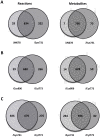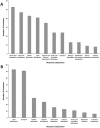Reconstruction and comparison of the metabolic potential of cyanobacteria Cyanothece sp. ATCC 51142 and Synechocystis sp. PCC 6803
- PMID: 23133581
- PMCID: PMC3487460
- DOI: 10.1371/journal.pone.0048285
Reconstruction and comparison of the metabolic potential of cyanobacteria Cyanothece sp. ATCC 51142 and Synechocystis sp. PCC 6803
Abstract
Cyanobacteria are an important group of photoautotrophic organisms that can synthesize valuable bio-products by harnessing solar energy. They are endowed with high photosynthetic efficiencies and diverse metabolic capabilities that confer the ability to convert solar energy into a variety of biofuels and their precursors. However, less well studied are the similarities and differences in metabolism of different species of cyanobacteria as they pertain to their suitability as microbial production chassis. Here we assemble, update and compare genome-scale models (iCyt773 and iSyn731) for two phylogenetically related cyanobacterial species, namely Cyanothece sp. ATCC 51142 and Synechocystis sp. PCC 6803. All reactions are elementally and charge balanced and localized into four different intracellular compartments (i.e., periplasm, cytosol, carboxysome and thylakoid lumen) and biomass descriptions are derived based on experimental measurements. Newly added reactions absent in earlier models (266 and 322, respectively) span most metabolic pathways with an emphasis on lipid biosynthesis. All thermodynamically infeasible loops are identified and eliminated from both models. Comparisons of model predictions against gene essentiality data reveal a specificity of 0.94 (94/100) and a sensitivity of 1 (19/19) for the Synechocystis iSyn731 model. The diurnal rhythm of Cyanothece 51142 metabolism is modeled by constructing separate (light/dark) biomass equations and introducing regulatory restrictions over light and dark phases. Specific metabolic pathway differences between the two cyanobacteria alluding to different bio-production potentials are reflected in both models.
Conflict of interest statement
Figures






References
-
- Schopf J (2000) The Fossil Record: Tracing the Roots of the Cyanobacterial Lineage. In: B W, Dordrecht PM, editors. The ecology of cyanobacteria: Kluwer Academic Publishers. 13–35.
-
- Moisander PH, Beinart RA, Hewson I, White AE, Johnson KS, et al. (2010) Unicellular cyanobacterial distributions broaden the oceanic N2 fixation domain. Science 327: 1512–1514. - PubMed
-
- Bryant DA, Frigaard NU (2006) Prokaryotic photosynthesis and phototrophy illuminated. Trends Microbiol 14: 488–496. - PubMed
-
- Popa R, Weber PK, Pett-Ridge J, Finzi JA, Fallon SJ, et al. (2007) Carbon and nitrogen fixation and metabolite exchange in and between individual cells of Anabaena oscillarioides. Isme Journal 1: 354–360. - PubMed
Publication types
MeSH terms
Substances
LinkOut - more resources
Full Text Sources
Other Literature Sources

